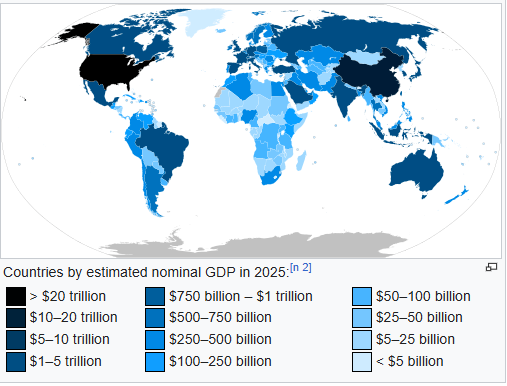
In 2025, the global economic landscape continues to be dominated by a few major players, led by economic powerhouses such as the United States and China. GDP, or Gross Domestic Product, is one of the most widely used indicators of a country’s economic performance. It measures the total market value of all goods and services produced over a specific time period.
In this post, we explore the top 10 countries by nominal GDP in 2025, provide comparative insights, and examine what this data tells us about global economic trends.
What is Nominal GDP?
Nominal GDP measures a country’s economic output using current prices, without adjusting for inflation. It reflects the actual market value of products and services and is often used to compare the economic size of different countries in U.S. dollars.
Top 10 Economies in 2025 by Nominal GDP
Here is a table showing the top 10 countries in the world based on their nominal GDP for 2025:
| Rank | Country | GDP (USD Trillions) |
|---|---|---|
| 1 | United States | $30.51 |
| 2 | China | $19.23 |
| 3 | Germany | $4.74 |
| 4 | India | $4.19 |
| 5 | Japan | $4.19 |
| 6 | United Kingdom | $3.83 |
| 7 | France | $3.21 |
| 8 | Italy | $2.42 |
| 9 | Canada | $2.23 |
| 10 | Brazil | $2.12 |
Visualizing the Data
Here’s a bar chart that visualizes the GDP of the top 10 countries in 2025:
*The chart highlights the massive economic gap between the U.S. and other countries, even China.
Key Observations
1. United States Retains Its Crown
With a staggering GDP of $30.51 trillion, the United States remains the world’s largest economy. A strong service sector, tech innovation, and financial markets drive its performance.
2. China: The Global Challenger
At $19.23 trillion, China continues to hold the second position. Although its growth has slowed in recent years, China’s industrial strength and increasing domestic consumption keep it firmly in the #2 spot.
3. India Equals Japan
India’s rise to tie Japan at $4.19 trillion is significant. With a booming tech industry, expanding middle class, and high domestic consumption, India is on track to potentially surpass Japan soon.
4. Europe Holds Strong
Germany, the UK, France, and Italy represent the strength of the European Union (and post-Brexit UK) in the global economy. Despite challenges such as inflation and energy crises, these nations maintain robust GDPs.
5. Brazil and Canada: Regional Leaders
Brazil is the top economy in South America, while Canada leads in North America after the U.S., showing their importance as regional powerhouses.
Why GDP Matters
Policy Making: Helps governments in budget planning, inflation control, and fiscal policy.
Investment Decisions: International investors use GDP to gauge economic stability and growth potential.
Economic Health: It indicates the standard of living and economic well-being of a country’s citizens.
What’s Next?
While GDP is a useful economic measure, it’s important to consider:
Purchasing Power Parity (PPP) for cost-of-living comparisons.
GDP per Capita for a per-person income perspective.
Sustainability Indexes for understanding long-term viability.
References
- Image – Wikipedia
Conclusion:
The world economy in 2025 continues to be shaped by major economic forces such as innovation, population growth, geopolitical shifts, and policy reforms. Keeping an eye on GDP trends is vital for businesses, governments, and investors looking to navigate the evolving global landscape.


